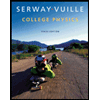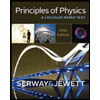To test the speed of a bullet, you create a pendulum by attaching a 3.20 kg wooden block to the bottom of a 1.10 m long, 0.800 kg rod. The top of the rod is attached to a frictionless axle and is free to rotate about that point. You fire a 10 g bullet into the block, where it sticks, and the pendulum swings out to an angle of 38.0°. What was the speed of the bullet? (Treat the wooden block as a particle.)
To test the speed of a bullet, you create a pendulum by attaching a 3.20 kg wooden block to the bottom of a 1.10 m long, 0.800 kg rod. The top of the rod is attached to a frictionless axle and is free to rotate about that point. You fire a 10 g bullet into the block, where it sticks, and the pendulum swings out to an angle of 38.0°. What was the speed of the bullet? (Treat the wooden block as a particle.)
College Physics
10th Edition
ISBN:9781285737027
Author:Raymond A. Serway, Chris Vuille
Publisher:Raymond A. Serway, Chris Vuille
Chapter7: Rotational Motion And The Law Of Gravity
Section: Chapter Questions
Problem 58AP
Related questions
Topic Video
Question
To test the speed of a bullet, you create a pendulum by attaching a 3.20 kg wooden block to the bottom of a 1.10 m long, 0.800 kg rod. The top of the rod is attached to a frictionless axle and is free to rotate about that point.
You fire a 10 g bullet into the block, where it sticks, and the pendulum swings out to an angle of 38.0°. What was the speed of the bullet?
(Treat the wooden block as a particle.)
Expert Solution
This question has been solved!
Explore an expertly crafted, step-by-step solution for a thorough understanding of key concepts.
This is a popular solution!
Step 1
VIEWTrending now
This is a popular solution!
Step by step
Solved in 1 steps

Knowledge Booster
Learn more about
Need a deep-dive on the concept behind this application? Look no further. Learn more about this topic, physics and related others by exploring similar questions and additional content below.Recommended textbooks for you

College Physics
Physics
ISBN:
9781285737027
Author:
Raymond A. Serway, Chris Vuille
Publisher:
Cengage Learning

Principles of Physics: A Calculus-Based Text
Physics
ISBN:
9781133104261
Author:
Raymond A. Serway, John W. Jewett
Publisher:
Cengage Learning

College Physics
Physics
ISBN:
9781285737027
Author:
Raymond A. Serway, Chris Vuille
Publisher:
Cengage Learning

Principles of Physics: A Calculus-Based Text
Physics
ISBN:
9781133104261
Author:
Raymond A. Serway, John W. Jewett
Publisher:
Cengage Learning